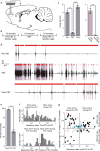A prefrontal cortex-brainstem neuronal projection that controls response to behavioural challenge
- PMID: 23160494
- PMCID: PMC5929119
- DOI: 10.1038/nature11617
A prefrontal cortex-brainstem neuronal projection that controls response to behavioural challenge
Abstract
The prefrontal cortex (PFC) is thought to participate in high-level control of the generation of behaviours (including the decision to execute actions); indeed, imaging and lesion studies in human beings have revealed that PFC dysfunction can lead to either impulsive states with increased tendency to initiate action, or to amotivational states characterized by symptoms such as reduced activity, hopelessness and depressed mood. Considering the opposite valence of these two phenotypes as well as the broad complexity of other tasks attributed to PFC, we sought to elucidate the PFC circuitry that favours effortful behavioural responses to challenging situations. Here we develop and use a quantitative method for the continuous assessment and control of active response to a behavioural challenge, synchronized with single-unit electrophysiology and optogenetics in freely moving rats. In recording from the medial PFC (mPFC), we observed that many neurons were not simply movement-related in their spike-firing patterns but instead were selectively modulated from moment to moment, according to the animal's decision to act in a challenging situation. Surprisingly, we next found that direct activation of principal neurons in the mPFC had no detectable causal effect on this behaviour. We tested whether this behaviour could be causally mediated by only a subclass of mPFC cells defined by specific downstream wiring. Indeed, by leveraging optogenetic projection-targeting to control cells with specific efferent wiring patterns, we found that selective activation of those mPFC cells projecting to the brainstem dorsal raphe nucleus (DRN), a serotonergic nucleus implicated in major depressive disorder, induced a profound, rapid and reversible effect on selection of the active behavioural state. These results may be of importance in understanding the neural circuitry underlying normal and pathological patterns of action selection and motivation in behaviour.
Figures




Comment in
-
Psychiatric disorders: A motivating microcircuit.Nat Rev Neurosci. 2013 Jan;14(1):4-5. doi: 10.1038/nrn3415. Epub 2012 Dec 5. Nat Rev Neurosci. 2013. PMID: 23212546 No abstract available.
-
Motivated action: new light on prefrontal-neuromodulatory circuits.Curr Biol. 2013 Feb 18;23(4):R161-3. doi: 10.1016/j.cub.2012.12.028. Curr Biol. 2013. PMID: 23428329
References
-
- Ridderinkhof KR, van den Wildenberg WPM, Segalowitz SJ, Carter CS. Neurocognitive mechanisms of cognitive control: the role of prefrontal cortex in action selection, response inhibition, performance monitoring, and reward-based learning. Brain and cognition. 2004;56:129–40. - PubMed
-
- Mayberg HS, et al. Reciprocal limbic-cortical function and negative mood: converging PET findings in depression and normal sadness. The American journal of psychiatry. 1999;156:675–82. - PubMed
-
- Maes M, Meltzer H. The serotonin hypothesis of major depression. Psychopharmacology: the fourth generation of progress. 1995:933–44.
Publication types
MeSH terms
Grants and funding
LinkOut - more resources
Full Text Sources
Other Literature Sources
Miscellaneous

